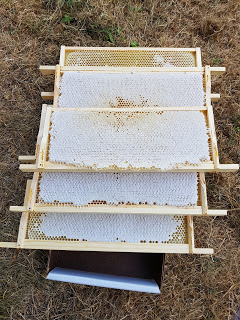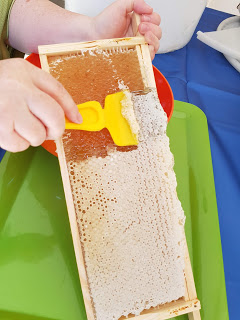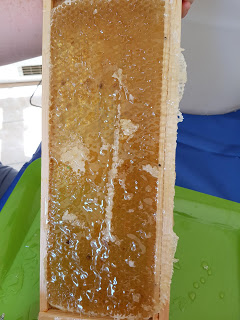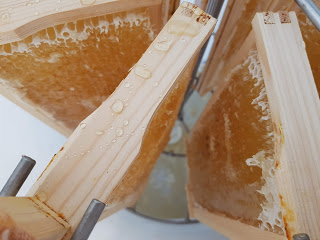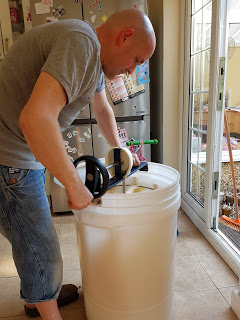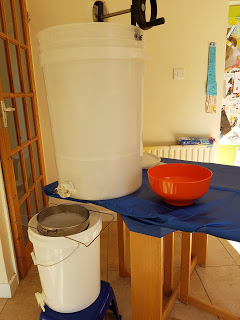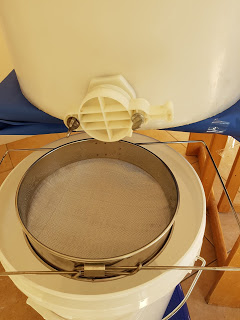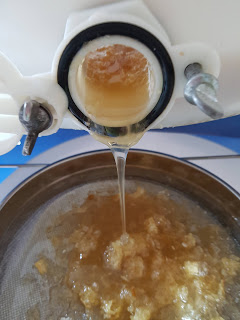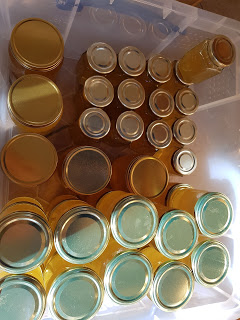Honey – its a-coming!
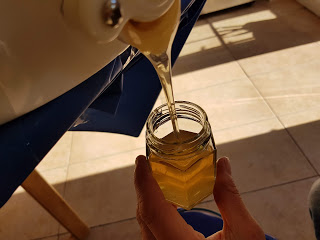
The moment has arrived! We are honey producers.
It seemed very complicated but actually if you follow the process it’s not so bad. We had to get the frames from the hive, well that sounds easy. Lets not mention the tens of thousands of bees who are adamant that they do not want you to rob the honey they have spent so much time making. The advice we had was to ‘brush the bees off the frame gently’. Well, that’s easier said than done to be honest. Once brushed off they don’t pop off to the flowers and trees to get some more, they buzz around your head, batting into you and buzzing with fury. This is a task to do quickly!
Here are the frames we robbed from the bees
Once we got them home, we had to scrap off the wax cappings that the bees had sealed the cells with to keep the honey fresh. This was with our new uncapping tool, which I have to say was a good choice (and a cheap cheap bargain!!) and worked really well. It was an easy job which looked complicated and made me look like an expert, this I liked quite a lot. To be fair Hubby could do it too, we both looked like experts that day. We revelled in it.
This is the uncapping process
Then we have to check the water content with the spectrometer – this sounds scientific huh? Oh yes, how cool is this. Actually its really important as if we use honey that’s got a water content that is too high it will ferment and turn black or look at bit dodgy. The water content has to be under 20%, all of our frames were around 15, 16 sometimes 17 or 18% so we could use it all. If you have a frame that is a bit higher once its extracted and mixed together it is likely to be ok. You would have to keep a close eye though if you were getting over 20%.
After this the honey can be extracted in the extractor. This is a barrel which you spin around by a handle after you have fixed the frames inside. One important things to remember – don’t spin too hard as the frames collapse from excessive centrifugal force – this would have been useful to know beforehand. The honey is forced out on the outside wall of the barrel and then drips down in to the bottom. Eventually all your honey is off the frames and sitting ready to be filtered.
The frames in the extractor
Hubby extracting
The set up
Next step is to open the honey gate, this is the tap which lets the honey run out of the extractor into your filter. You are not allowed to filter honey too much, if you do you have to sell it as filtered honey rather than just honey. The filter is really two sieves of different gauges that take out all the bits you don’t really want to be eating – eggs, dead bees, wax, grass , pine needles – a whole bunch of stuff.
This is the honey coming out of the gate after extraction, you can see the bits in it.
This is a bit later in the same process where the honey was running clearer
Finally the honey is resting in the honey settling tank, this is really a bucket with a honey gate on the bottom but because ‘honey settling tank’ sounds much more technical they cost £20 each. We had various bits of advice about how long to leave the honey in here, some people said let the bubbles rise for 24 hours, others said it didn’t matter one jot and do whatever you like.
So imagine – your first go at producing honey, the jars are ready, the honey is sitting there, some people said it didn’t matter if we waited for not – did we wait? Oh no, its taken months to get here, we are off filling asap.
The honey!
